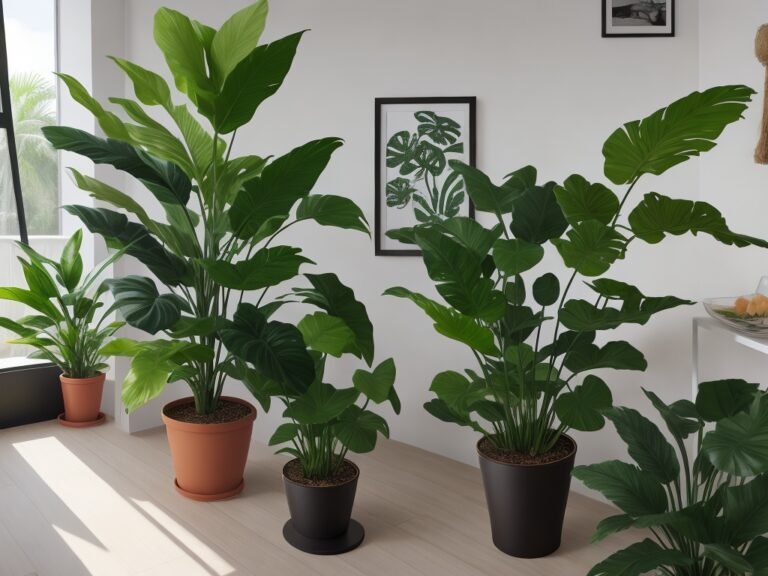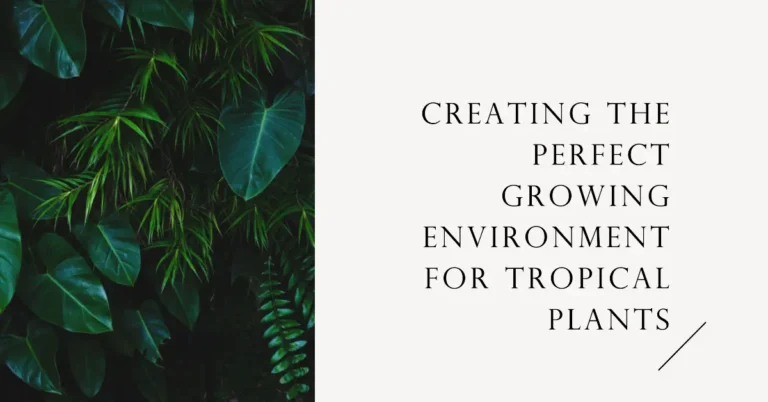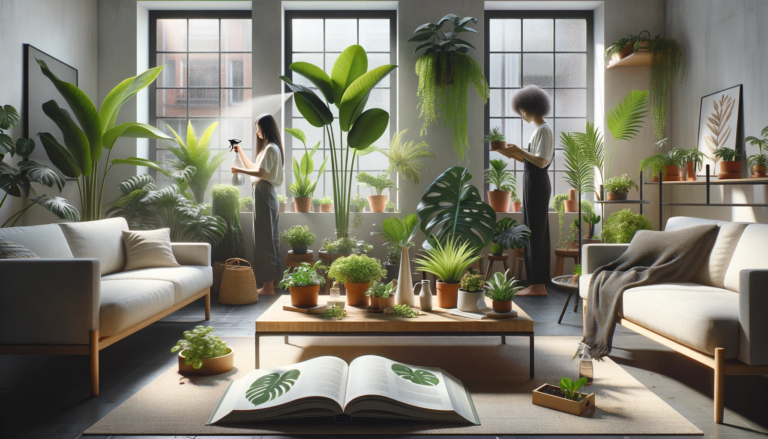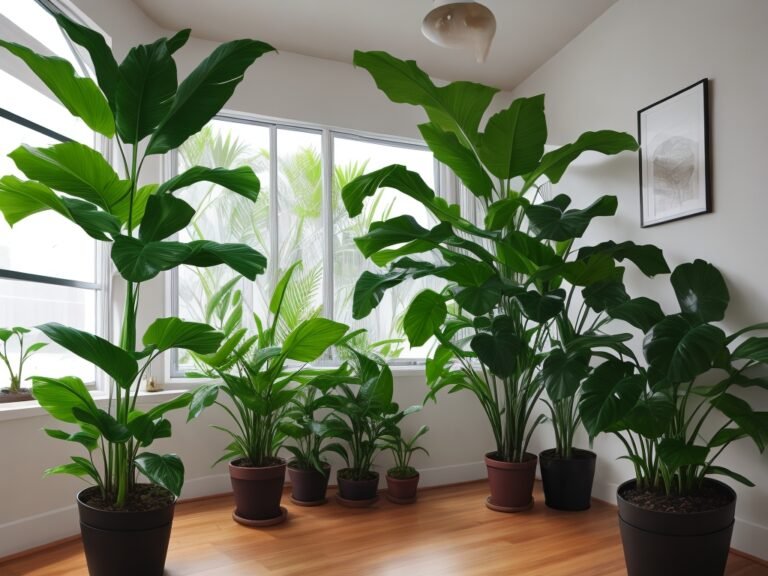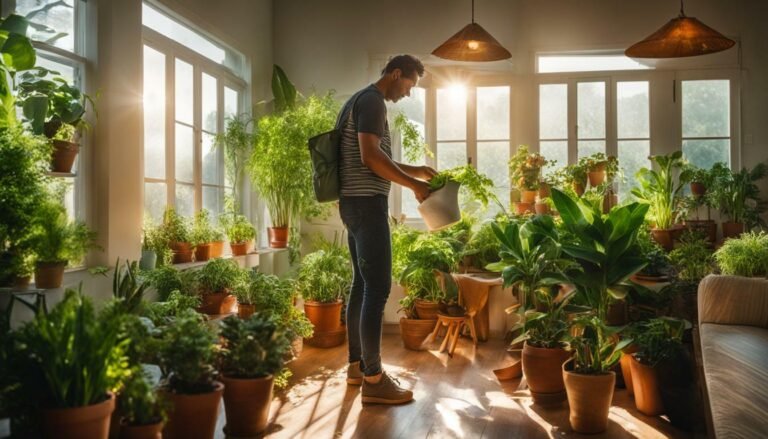The Complete Beginner’s Guide To Caring For Tropical Plants
Key Takeaways:
- Understanding the specific needs of tropical plants is crucial for their proper care and growth.
- Providing the right amount of sunlight, water, and humidity is essential for the well-being of tropical plants.
- Regular fertilization and proper pruning will help tropical plants thrive and maintain their health.
- Being aware of common pests and diseases that affect tropical plants can help prevent and treat issues promptly.
Are you a plant enthusiast eager to bring the vibrant and lush beauty of tropical plants into your home? Look no further! This complete beginner’s guide is here to help you care for your tropical plants with expert advice and easy-to-follow tips.
From choosing the right plants for your home and creating the ideal growing environment to troubleshooting common issues and even propagating and repotting techniques, this guide has got you covered.
Get ready to transform your space into a tropical oasis that will leave both you and your plants thriving. Let’s dive in and discover the secrets to successfully caring for tropical plants!
| Tropical Plant Care | Description |
|---|---|
| Lighting | Tropical plants generally require bright but indirect light. Some may tolerate lower light levels. |
| Temperature | Maintain a temperature range between 65°F – 85°F (18°C – 29°C). Avoid extreme temperature fluctuations. |
| Humidity | Tropical plants thrive in high humidity. Mist the leaves or place a humidifier nearby to increase humidity levels. |
| Watering | Keep the soil consistently moist, but not waterlogged. Ensure proper drainage with well-draining soil. |
| Fertilization | Feed tropical plants with a balanced liquid fertilizer once a month during the growing season (spring and summer). |
| Pruning | Remove dead or yellowing leaves regularly. Trim back overgrown branches to maintain the desired shape. |
| Pests and Diseases | Monitor for common tropical plant pests like aphids and spider mites. Treat any infestations promptly with organic insecticides. |
| Propagation | Many tropical plants can be propagated through stem cuttings or division. Follow specific plant propagation guidelines. |
| Common Tropical Plants | Examples: Monstera deliciosa, Peace Lily, Chinese Money Plant, Bird of Paradise, Philodendron, and Calathea. |
Choosing the Right Tropical Plants for Your Home
When choosing tropical plants for your home, consider the lighting conditions, temperature, and humidity levels. It’s also important to research the specific care requirements of different tropical plant species.
Consider Your Home’s Lighting Conditions
Consider the lighting conditions in your home when choosing tropical plants. Some plants thrive in bright, direct sunlight, while others prefer indirect or low-light settings.
Assess the natural light available in each room and choose plants that are suited to those conditions.

Assess Your Home’s Temperature and Humidity Levels
Assessing the temperature and humidity levels in your home is essential for the well-being of your tropical plants.
Use a hydrometer to measure humidity levels, aiming for 50-60%.
Keep temperatures between 65-75°F during the day, and slightly cooler at night.
Avoid placing plants near drafts or heat sources.
Regularly monitor and adjust as needed.

Research the Care Requirements of Different Tropical Plants
To properly care for tropical plants, it’s important to research their specific care requirements.
Some key factors to consider include lighting conditions, temperature, humidity levels, watering techniques, fertilization needs, and any specific care instructions unique to the plant species.
Consulting reliable plant guides or reaching out to experts can provide valuable information on how to best care for different tropical plants.
Additionally, considering your own availability and expertise in plant care can help you choose plants that align with your capabilities and lifestyle.

Providing the Ideal Growing Environment for Tropical Plants
To provide the ideal growing environment for your tropical plants, pay attention to factors such as pot selection, potting mix, watering techniques, fertilizer needs, and humidity level.
Selecting the Right Pot or Container
Selecting the right pot or container for your tropical plants is essential for their health and growth.
Here are a few tips to help you make the best choice:
- Consider the size: Choose a pot that allows room for the plant’s roots to grow. Avoid pots that are too small or too large, as they can hinder proper root development.
- Look for drainage holes: Ensure that the pot has drainage holes to allow excess water to escape. This helps prevent waterlogging and root rot.
- Opt for material: Select a pot made of a material that suits your plant’s needs. Clay pots are porous and allow better airflow, while plastic pots retain moisture better.
- Consider the aesthetic: Choose a pot that complements your tropical plant’s foliage and overall look. There are various colors, shapes, and designs to choose from, so have fun with it!
Remember, selecting the right pot is just the first step in providing the ideal growing environment for your tropical plants.
Combine it with the appropriate potting mix, proper watering techniques, and suitable lighting conditions to ensure their overall health and well-being.

Proper Watering Techniques for Tropical Plants
Proper watering techniques are essential for the health of tropical plants.
Here’s what you need to know:
- Always check the moisture level of the soil before watering. Stick your finger about an inch into the soil, and if it feels dry, it’s time to water.
- Avoid overwatering, as it can lead to root rot. Water thoroughly, allowing excess water to drain away.
- Water your tropical plants deeply, providing enough moisture to reach the roots.
- Consider using room-temperature water, as cold water can shock the plants.
- Be mindful of the specific needs of your tropical plants. Some may require more frequent watering, while others prefer drier conditions.
- Use a watering can or a watering wand to control the amount and direction of water, preventing damage to leaves and flowers.
Remember, each plant has its own watering requirements, so it’s crucial to research and understand the care needs of your specific tropical plants.
Understanding Fertilizer Needs
Understanding the fertilizer needs of your tropical plants is essential for their growth and health. It’s important to choose a fertilizer specifically formulated for tropical plants and follow the recommended application instructions.
Regular fertilizing during the growing season can help provide essential nutrients and promote lush foliage and vibrant blooms.
Creating a Suitable Humidity Level
To create a suitable humidity level for your tropical plants, consider placing a humidifier near them or using a pebble tray filled with water.
Grouping plants together can also help create humidity.
Mist your plants regularly, but avoid overwatering.
Monitor the humidity levels with a hygrometer and make adjustments as needed.
Placement and Display Options for Tropical Plants
Want to showcase your tropical plants?
Learn how to find the perfect spot, group plants based on care needs, incorporate plants into different rooms, and use creative planters and hanging baskets.
Finding the Right Spot for Your Tropical Plants
Finding the right spot for your tropical plants is essential for their health and growth.
Consider the lighting conditions in your home and match them to the plant’s needs.
Assess the temperature and humidity levels to ensure they align with the plant’s requirements.
Lastly, research the care requirements of different tropical plants to find the best spot for each one.
Grouping Plants with Similar Care Requirements
To group plants with similar care requirements, you need to consider factors like lighting, temperature, humidity, and watering needs.
Research the care requirements of different plants and group them accordingly.
This will ensure that each plant receives the ideal conditions for growth and thrive together.
Incorporating Tropical Plants into Different Rooms of Your Home
Incorporating tropical plants into different rooms of your home can add a touch of freshness and vibrancy. Here are a few ideas for incorporating tropical plants into specific rooms:
- Living Room: Place a lush, large leafed plant like a Monstera or a Bird of Paradise as a focal point in your living room. Smaller plants like Peace Lilies or Snake Plants can be placed on side tables or shelves.
- Bedroom: Create a relaxing and serene atmosphere in your bedroom with plants like English Ivy or a Boston Fern. These plants can help improve air quality and add a calming ambiance to your space.
- Bathroom: Tropical plants that thrive in high humidity, such as Spider Plants or Pothos, are perfect for the bathroom. Hang them in baskets or place them on a windowsill for a spa-like feel.
- Kitchen: Herbs like Basil, Mint, or Rosemary can be grown on a sunny windowsill in the kitchen. Not only do they add a green touch, but they also provide fresh ingredients for cooking.
- Home Office: Boost productivity and enhance the aesthetics of your home office with a Dracaena or a ZZ Plant. These plants are low maintenance and can thrive in indoor environments with lower light.
Remember to consider the lighting and care requirements of each plant when choosing where to place them in your home. With a little creativity and knowledge about the needs of various tropical plants, you can transform any room into a lush and inviting space.
Using Creative Planters and Hanging Baskets
Using creative planters and hanging baskets is a great way to add visual interest and variety to your tropical plant collection.
You can choose from a wide range of unique and eye-catching options, such as repurposed containers, macrame hangers, or wall-mounted planters.
This allows you to showcase your plants in different areas of your home and create a visually appealing display.
Just make sure to choose planters that are appropriate for the size of your plants and provide adequate drainage.
Essential Care Tips for Tropical Plants
Ready to learn how to care for your tropical plants? Here are some essential tips to keep in mind.
Regularly Monitoring and Adjusting Lighting Conditions
Regularly monitoring and adjusting lighting conditions is crucial for the health and growth of your tropical plants.
Here’s what you need to do:
- Assess the natural light levels in the area where your plants are located. Take note of how much direct sunlight they receive throughout the day.
- Different tropical plants have varying light requirements. Research the specific needs of your plants and make sure they are getting the right amount of light.
- If your plants aren’t receiving enough light, consider moving them closer to a window or providing supplemental lighting with grow lights.
- On the other hand, if your plants are getting too much direct sunlight, move them to a spot with filtered or indirect light.
- Regularly rotate your plants to ensure even light distribution and prevent them from leaning towards the light source.
- Lastly, pay attention to any signs of light deficiency or excess, such as leggy growth or scorched leaves. Adjust the lighting accordingly to provide optimum conditions for your tropical plants.
By regularly monitoring and adjusting the lighting conditions, you’ll be able to provide the right amount of light that your tropical plants need for healthy growth and vibrant foliage.
Managing Temperature and Humidity Levels
To manage temperature and humidity levels for your tropical plants, it’s important to create a suitable environment. Maintaining a temperature range of 60-85°F (15-29°C) is ideal, avoiding extreme fluctuations.
Use a hygrometer to monitor humidity levels, aiming for 50-60%.
Mist your plants occasionally, place them near a humidifier, or group them together to increase humidity. Avoid placing them near drafts or vents to maintain stable conditions.
Pruning and Grooming Tropical Plants
Pruning and grooming tropical plants plays a key role in their overall health and appearance. By removing dead or damaged leaves, branches, and flowers, you can promote new growth and prevent the spread of diseases.
Regularly cleaning the foliage and removing dust also helps improve the plant’s ability to photosynthesize.
Dealing with Pests and Diseases
Dealing with pests and diseases is an important part of caring for tropical plants.
Regularly inspect your plants for any signs of pests like aphids or mealybugs, and promptly address any infestations.
Use natural remedies or insecticidal soaps to control pests.
For diseases, ensure good ventilation and avoid overwatering to prevent fungal infections.
If necessary, treat diseases with appropriate fungicides.
Reviving Stressed or Neglected Plants
To revive stressed or neglected plants, start by assessing their specific needs.
Adjust lighting, temperature, and humidity levels accordingly.
Trim away dead or damaged leaves and provide proper watering and fertilization.
Treat any pests or diseases promptly and consider repotting if necessary.
Patience and consistent care are key!
Troubleshooting Common Issues with Tropical Plants
Having trouble with your tropical plants? Here’s how to troubleshoot common issues.
Identifying and Treating Leaf Browning or Yellowing
Leaf browning or yellowing in tropical plants can be caused by various factors such as overwatering, underwatering, nutrient deficiencies, pests, or diseases.
To identify the cause, assess the plant’s watering schedule, check soil moisture, inspect for pests or signs of disease, and evaluate nutrient levels.
Treatments may include adjusting watering habits, providing appropriate nutrients, addressing pests or diseases with organic solutions or insecticides, and improving overall plant care.
Managing Overwatered or Underwatered Plants
To manage overwatered or underwatered plants, it’s important to find the right balance. For overwatered plants, allow the soil to dry out before watering again and ensure proper drainage.
For underwatered plants, increase watering frequency and check for signs of wilting.
Adjust watering based on the specific plant’s needs.
Preventing and Treating Pest Infestations
To prevent and treat pest infestations in your tropical plants, there are a few key steps you can take. First, inspect your plants regularly for signs of pests such as tiny insects or webs.
If you spot any pests, isolate the affected plant to prevent the infestation from spreading.
Secondly, practice good plant hygiene by regularly cleaning your plants and removing any dead or decaying plant material. This will help eliminate potential breeding grounds for pests.
Additionally, you can use natural pest control methods like neem oil or insecticidal soap to help manage pest populations.
Always follow the instructions and use these products sparingly to avoid harming your plants. Lastly, remember that prevention is key – keep your plants healthy by providing the right growing conditions, including proper watering, light exposure, and good air circulation.
This will help strengthen your plants’ natural defenses against pests.
Addressing Mold or Fungus Growth
Addressing mold or fungus growth on tropical plants requires prompt action.
Here are some tips:
- Remove affected leaves or parts of the plant immediately to prevent further spread.
- Improve air circulation by placing a fan near the plant or opening windows.
- Avoid overwatering and ensure proper drainage to prevent excess moisture.
- Apply a fungicide specifically designed for plants, following the instructions carefully.
- Adjust the humidity levels in the room, if possible, to create a less favorable environment for mold and fungus growth.
- Keep the plant clean by regularly wiping the leaves with a damp cloth and removing any debris or dead plant matter.
Dealing with Wilting or Drooping Plants
Wilting or drooping plants can be a sign of various issues, but most commonly they are caused by improper watering. To deal with this, the first step is to check the moisture level in the soil.
If it’s dry, give the plant a good drink.
If it’s wet, allow the soil to dry out before watering again. Make sure to provide adequate sunlight and avoid placing the plant near drafts.
If the problem persists, consider adjusting the humidity levels or repotting the plant.
Propagation and Repotting Techniques for Tropical Plants
One important aspect of caring for tropical plants is propagation, which involves creating new plants from existing ones. Another important technique is repotting, which helps to ensure that the plants have enough space and nutrients to thrive.
Propagating Tropical Plants through Stem Cuttings
To propagate tropical plants through stem cuttings, start by selecting a healthy, mature plant.
Cut a 4-6 inch section from a stem just below a leaf node.
Remove the lower leaves and dip the cut end in rooting hormone.
Place the cutting in a pot with well-draining soil and keep it moist.
In a few weeks, roots should begin to form, indicating successful propagation.
Dividing and Potting Tropical Plants
Dividing and potting tropical plants is a great way to propagate and rejuvenate your plants.
Here’s how you can do it:
- Start by gently removing the plant from its pot and carefully separate the clumps or sections of the plant.
- Ensure that each section has a healthy root system attached to it. Trim any damaged or dead roots.
- Choose a suitable pot or container for each section. Make sure it has drainage holes to prevent waterlogging.
- Fill the pots with a well-draining potting mix that is specifically formulated for tropical plants.
- Place each section in its own pot, making sure the roots are covered with soil and the plant is stable.
- Water the newly potted plants thoroughly and place them in a location with appropriate lighting and temperature conditions.
- Monitor the plants closely in the following weeks, ensuring they receive adequate water and proper care.
Remember, dividing and potting tropical plants can help them grow healthier and allow you to expand your collection.
Rejuvenating Overgrown Plants through Root Pruning and Repotting
To rejuvenate overgrown plants, root pruning and repotting are essential. First, gently remove the plant from its pot and inspect the roots.
Trim any circling or tangled roots to promote healthier growth.
Repot the plant in a larger container with fresh potting mix. Water thoroughly and place in a suitable location for proper growth.
Frequently Asked Questions about Caring for Tropical Plants
How often should I water my tropical plants?
Tropical plants generally prefer consistently moist but not waterlogged soil. Water your tropical plants when the top inch of soil feels dry to the touch.
Avoid overwatering, as this can lead to root rot.
Use your finger or a moisture meter to check the soil moisture level. Water more frequently during hot and dry periods, and adjust watering based on the plant’s specific needs.
What are some common pests that affect tropical plants and how can I control them?
Common pests that affect tropical plants include aphids, mealybugs, spider mites, and scale insects.
To control them, you can use insecticidal soap or neem oil to physically remove and kill the pests.
Additionally, regularly inspecting your plants and maintaining good plant hygiene can help prevent infestations.
How do I know if a tropical plant is receiving adequate light?
To determine if a tropical plant is getting enough light, observe its leaves. Are they dark green and healthy?
That means it’s likely receiving adequate light.
If the leaves are pale, elongated, or dropping, it may be getting too much light. And if the leaves are turning yellow and the plant is stretching towards light sources, it may need more light.
Keep an eye on your plant’s appearance and adjust its lighting accordingly!
Can I grow tropical plants in a location with low humidity?
Yes, you can grow tropical plants in a location with low humidity. However, it is important to choose tropical plant varieties that are more tolerant of drier conditions.
Some examples include snake plants, pothos, peace lilies, and ZZ plants.
These plants have adaptations that allow them to thrive in lower humidity environments. It’s also helpful to provide them with occasional misting or use a humidifier to increase the humidity around them.
When should I repot my tropical plants?
You should repot your tropical plants when they outgrow their current container or when you notice roots coming out of the drainage holes. This is usually indicated by slow growth or the plant becoming root-bound.
Repotting is best done during the spring or summer when the plant is actively growing.
Ensure the new pot is slightly larger and use well-draining potting mix.
Final Verdict
Caring for tropical plants requires careful consideration of their lighting, temperature, and humidity needs, as well as proper potting, watering, and fertilization techniques.
Placement and display options should be chosen based on the specific requirements of each plant, and regular monitoring and grooming are essential to maintain their health and beauty.
Troubleshooting common issues, propagating and repotting techniques, and FAQs provide additional guidance for successful tropical plant care.
By following these tips and strategies, you can create a thriving tropical oasis in your own home.


